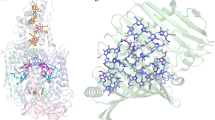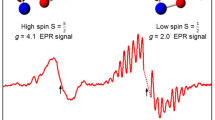Abstract
In our recent X-ray study, we demonstrated that substitution of the natural leucine residue M196 with histidine in the reaction center (RC) from Rhodobacter (Rba.) sphaeroides leads to formation of a close contact between the genetically introduced histidine and the primary electron donor P (bacteriochlorophylls (BChls) PA and PB dimer) creating a novel pigment—protein interaction that is not observed in native RCs. In the present work, the possible nature of this novel interaction and its effects on the electronic properties of P and the photochemical charge separation in isolated mutant RCs L(M196)H are investigated at room temperature using steady-state absorption spectroscopy, light-induced difference FTIR spectroscopy, and femtosecond transient absorption spectroscopy. The results are compared with the data obtained for the RCs from Rba. sphaeroides pseudo-wild type strain. It is shown that the L(M196)H mutation results in a decrease in intensity and broadening of the long-wavelength Qy absorption band of P at ∼865 nm. Due to the mutation, there is also weakening of the electronic coupling between BChls in the radical cation P+ and increase in the positive charge localization on the PA molecule. Despite the significant perturbations of the electronic structure of P, the mutant RCs retain high electron transfer rates and quantum yield of the P+Q −A state (QA is the primary quinone acceptor), which is close to the one observed in the native RCs. Comparison of our results with the literature data suggests that the imidazole group of histidine M196 forms a π-hydrogen bond with the π-electron system of the PB molecule in the P dimer. It is likely that the specific (T-shaped) spatial organization of the π-hydrogen interaction and its potential heterogeneity in relation to the bonding energy is, at least partially, the reason that this type of interaction between the protein and the pigment and quinone cofactors is not realized in the native RCs.
Similar content being viewed by others
Abbreviations
- ΔA:
-
absorbance change
- BA :
-
monomeric bacteriochlorophyll in the active cofactors branch
- BChl:
-
bacteriochlorophyll
- BPheo:
-
bacteriopheophytin
- EADS:
-
evolution-associated decay spectra
- FTIR:
-
Fourier transform infrared spectroscopy
- HA and HB :
-
BPheo molecules in the active and inactive cofactor branches, respectively
- P:
-
primary electron donor, BChl dimer
- PA and PB :
-
BChl molecules constituting P
- psWt:
-
pseudo-wild type
- QA :
-
primary quinone acceptor
- QB :
-
secondary quinone acceptor
- Rba. sphaeroides :
-
Rhodobacter sphaeroides
- RC:
-
reaction center
References
Liao, S. M., Du, Q. S., Meng, J. Z., Pang, Z. W., and Huang, R. B. (2013) The multiple roles of histidine in protein interactions, Chem. Cent. J., 7, 44–55, DOI: https://doi.org/10.1186/1752-153X-7-44.
Fufina, T. Y., Vasilieva, L. G., Gabdulkhakov, A. G., and Shuvalov, V. A. (2015) The L(M196)H mutation in Rhodobacter sphaeroides reaction center results in new electrostatic interactions, Photosynth. Res., 125, 23–29, DOI: https://doi.org/10.1007/s11120-014-0062-0.
Lutz, M., and Mantele, W. (1991) Vibrational spectroscopy of chlorophylls, in Chlorophylls (Scheer, H., ed.) CRC Press, Boca Raton, FL, pp. 855–902.
Breton, J., Nabedryk, E., and Parson, W. W. (1992) A new infrared electronic transition of the oxidized primary electron donor in bacterial reaction centers: a way to assess resonance interactions between the bacteriochlorophylls, Biochemistry, 31, 7503–7510, DOI: https://doi.org/10.1021/bi00148a010.
Gabdulkhakov, A. G., Fufina, T. Y., Vasilieva, L. G., Mueller, U., and Shuvalov, V. A. (2013) Expression, purification, crystallization and preliminary X-ray structure analysis of wild-type and L(M196)H mutant Rhodobacter sphaeroides reaction centres, Acta. Crystallogr. Sect. F, 69, 506–509, DOI: https://doi.org/10.1107/S1744309113006398.
Zabelin, A. A., Fufina, T. Y., Vasilieva, L. G., Shkuropatova, V. A., Zvereva, M. G., Shkuropatov, A. Y., and Shuvalov, V. A. (2009) Mutant reaction centers of Rhodobacter sphaeroides I(L177)H with strongly bound bacteriochlorophyll a: structural properties and pigment-protein interactions, Biochemistry (Moscow), 74, 68–74, DOI: https://doi.org/10.1134/S0006297909010106.
Khatypov, R. A., Khristin, A. M., Fufina, T. Yu., and Shuvalov, V. A. (2017) An alternative pathway of light-induced transmembrane electron transfer in photosynthetic reaction centers of Rhodobacter sphaeroides, Biochemistry (Moscow), 82, 692–697, DOI: https://doi.org/10.1134/S0006297917060050.
Van Stokkum, I. H. M., Larsen, D. S., and van Grondelle, R. (2004) Global and target analysis of time-resolved spectra, Biochim. Biophys. Acta, 1657, 82–104, DOI: https://doi.org/10.1016/j.bbabio.2004.04.011.
Snellenburg, J. J., Laptenok, S. P., Seger, R., Mullen, K. M., and van Stokkum, I. H. M. (2012) Glotaran: a Java-based graphical user interface for the R package TIMP, J. Stat. Soft., 49, 1–22, DOI: https://doi.org/10.18637/jss.v049.i03.
Thompson, M. A., Zerner, M. C., and Fajer, J. (1991) A theoretical examination of the electronic structure and excited states of the bacteriochlorophyll b dimer from Rhodopseudomonas viridis, J. Phys. Chem., 95, 5693–5700, DOI: https://doi.org/10.1021/j100167a058.
Parson, W. W., and Warshel, A. (1987) Spectroscopic properties of photosynthetic reaction centers. 2. Application of the theory to Rhodopseudomonas viridis, J. Am. Chem. Soc., 109, 6152–6163, doi: https://doi.org/10.1021/ja00254a040
Naberdyk, E., Allen, J. P., Taguchi, A. K. W., Williams, J. C., Woodbury, N. W, and Breton, J. (1993) Fourier transform infrared study of the primary electron donor in chromatophores of Rhodobacter sphaeroides with reaction centers genetically modified at residues M160 and L131, Biochemistry, 32, 13879–13885, DOI: https://doi.org/10.1021/bi00213a017.
Reimers, J. R., and Hush, N. S. (2003) Modeling the bacterial photosynthetic reaction center. VII. Full simulation of the intervalence hole-transfer absorption spectrum of the special-pair radical cation, J. Chem. Phys., 119, 3262–3277, DOI: https://doi.org/10.1063/1.1589742.
Malferrari, M., Turina, P., Francia, F., Mezzetti, A., Leibl, W., and Venturoli, G. (2015) Dehydration affects the electronic structure of the primary electron donor in bacterial photosynthetic reaction centers: evidence from visible-NIR and light-induced difference FTIR spectroscopy, Photochem. Photobiol. Sci., 14, 238–251, doi:https://doi.org/10.1039/c4pp00245h.
Sun, C., Carey, A.-M., Gao B.-R., Wraight, C. A., Woodbury, N. W., and Lin, S. (2016) Ultrafast electron transfer kinetics in the LM dimer of bacterial photosynthetic reaction center from Rhodobacter sphaeroides, J. Phys. Chem. B, 120, 5395–5404, DOI: https://doi.org/10.1021/acs.jpcb.6b05082.
Arlt, T., Schmidt, S., Kaiser, W., Lauterwasser, C., Meyer, M., Scheer, H., and Zinth, W. (1993) The accessory bacteriochlorophyll: a real electron carrier in primary photosynthesis, Proc. Natl. Acad. Sci. USA, 90, 11757–11761, DOI: https://doi.org/10.1073/pnas.90.24.11757.
Shkuropatov, A. Ya., and Shuvalov, V. A. (1993) Electron transfer in pheophytin a-modified reaction centers from Rhodobacter sphaeroides (R-26), FEBS Lett., 322, 168–172, DOI: https://doi.org/10.1016/0014-5793(93)81561-D.
Kennis, J. T. M., Shkuropatov, A. Ya., van Stokkum, I. H. M., Gast, P., Hoff, A. J., Shuvalov, V. A., and Aartsma, T. J. (1997) Formation of a long-lived P+B −A state in plant pheophytin-exchanged reaction centers of Rhodobacter sphaeroides R26 at low temperature, Biochemistry, 36, 16231–16238, DOI: https://doi.org/10.1021/bi9712605.
Zinth, W., and Wachtveitl, J. (2005) The first picoseconds in bacterial photosynthesis — ultrafast electron transfer for the efficient conversion of light energy, Chem. Phys. Chem., 6, 871–880, DOI: https://doi.org/10.1002/cphc.200400458.
Khatypov, R. A., Khmelnitskiy, A. Yu., Khristin, A. M., Fufina, T. Yu., Vasilieva, L. G., and Shuvalov, V. A. (2012) Primary charge separation within P870* in wild type and heterodimer mutants in femtosecond time domain, Biochim. Biophys. Acta, 1817, 1392–1398, DOI: https://doi.org/10.1016/j.bbabio.2011.12.007.
Vasilieva, L. G., Fufina, T. Y., Gabdulkhakov, A. G., Leonova, M. M., Khatypov, R. A., and Shuvalov, V. A. (2012) The site-directed mutation I(L177)H in Rhodobacter sphaeroides reaction center affects coordination of PA and BB bacteriochlorophylls, Biochim. Biophys. Acta, 1817, 1407–1417, DOI: https://doi.org/10.1016/j.bbabio.2012.02.008.
DeLano, W. L. (2002) The PyMOL molecular graphics system (http://www.pymol.org).
Lin, X., Murchison, H. A., Nagarajan, V., Parson, W. W., Allen, J. P., and Williams, J. C. (1994) Specific alteration of the oxidation potential of the electron donor in reaction centers from Rhodobacter sphaeroides, Proc. Natl. Acad. Sci. USA, 91, 10265–10269, DOI: https://doi.org/10.1073/pnas.91.22.10265.
Allen, J. P., and Williams, J. C. (1995) Relationship between the oxidation potential of the bacteriochlorophyll dimer and electron transfer in photosynthetic reaction centers, J. Bioenerg. Biomembr., 27, 275–283, DOI: https://doi.org/10.1007/BF02110097.
Williams, J. C., Alden, R. G., Murchison, H. A., Peloquin, J. M., Woodbury, N. W., and Allen, J. P. (1992) Effects of mutations near the bacteriochlorophylls in reaction centers from Rhodobacter sphaeroides, Biochemistry, 31, 11029–11037, DOI: https://doi.org/10.1021/bi00160a012.
Kaupp, M. (2002) The function of photosystem I. Quantum chemical insight into the role of tryptophan—quinone interactions, Biochemistry, 41, 2895–2900, DOI: https://doi.org/10.1021/bi0159783.
Wang, Y., Mao, L., and Hu, X. (2004) Insight into the structural role of carotenoids in the photosystem I: a quantum chemical analysis, Biophys. J., 86, 3097–3111, DOI: https://doi.org/10.1016/S0006-3495(04)74358-1.
Allen, J. P., and Williams, J. C. (2006) The influence of protein interactions on the properties of the bacteriochlorophyll dimer in reaction centers, in Chlorophylls and Bacteriochlorophylls: Biochemistry, Biophysics, Functions and Applications (Grimm, B., Porra, R. J., Rudiger, W., and Scheer, H., eds.) Springer, The Netherlands, pp. 283–295.
Bylina, E. J., Kirmaer, C., McDowell, L., Holten, D., and Youvan, D. C. (1988) Influence of an amino acid residue on the optical properties and electron transfer dynamics of a photosynthetic reaction centre complex, Nature, 336, 182–184, DOI: https://doi.org/10.1038/336182a0.
Flores, M., Isaacson, R., Abresch, E., Calvo, R., Lubitz, W., and Feher, G. (2007) Protein—cofactor interactions in bacterial reaction centers from Rhodobacter sphaeroides R-26: II. Geometry of the hydrogen bonds to the primary quinone Q −A by 1H and 2H ENDOR spectroscopy, Biophys. J., 92, 671–682, DOI: https://doi.org/10.1529/biophysj.106.092460.
Steiner, T., and Koellner, G. (2001) Hydrogen bonds with π-acceptors in proteins: frequencies and role in stabilizing local 3D structure, J. Mol. Biol., 305, 535–557, DOI: https://doi.org/10.1006/jmbi.2000.4301.
Du, Q.-S., Wang, Q.-Y., Du, L.-Q., Chen, D., and Huang, R.-B. (2013) Theoretical study on the polar hydrogen—π (Hp-π) interactions between protein side chains, Chem. Cent. J., 7, 92–99, DOI: https://doi.org/10.1186/1752-153X-7-92.
Author information
Authors and Affiliations
Corresponding author
Rights and permissions
About this article
Cite this article
Zabelin, A.A., Fufina, T.Y., Khristin, A.M. et al. Effect of Leucine M196 Substitution by Histidine on Electronic Structure of the Primary Electron Donor and Electron Transfer in Reaction Centers from Rhodobacter sphaeroides. Biochemistry Moscow 84, 520–528 (2019). https://doi.org/10.1134/S0006297919050067
Received:
Revised:
Accepted:
Published:
Issue Date:
DOI: https://doi.org/10.1134/S0006297919050067




